Charly Castillo
Laurie Accede
AP Art History 🖼
34 resourcesSee Units
The FFCCs of Unit 1
Unit 1 has 11 works, and you need to know all of their FFCCs (forms, functions, contents, and contexts) for the exam.
- Form- What materials is the artwork made from? What is its medium?
- Function- Why was this artwork created? What is its purpose?
- Content- What did the artist draw, paint, sculpt, etc.? What do you see in the image?
- Context- What is the history related to the image? All the circumstances around the works creation such as the location, time period, environment, etc.
This may sound like a daunting task, but luckily, Unit 1 is one of the shortest ones in the whole course. So, without further ado, the works of Unit 1.
Apollo 11 Stones
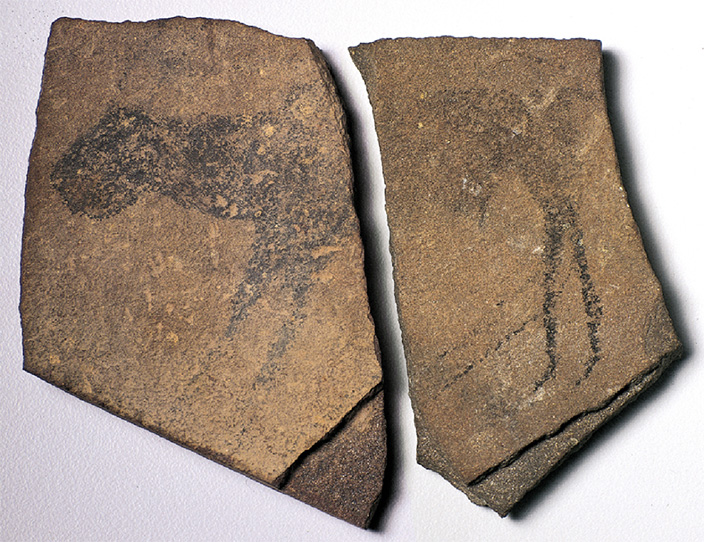
Image Courtesy of the State Museum of Namibia.
Form:
- Charcoal on stone
Function:
- The function is unknown, but being portable may have something to do with how it was once used. It could have been used for storytelling or for animal worship.
Content:
- The two most supported theories is that this work depicts either a four-legged animal common to the peoples' lives, or therianthrope (a mythical being that is part human and part animal) in profile.
- Art historians that believe that the work depicts a therianthrope say that the body is that of a feline and the legs are human, possibly those of a shaman.
Context:
- The stones were discovered the same year as the Apollo 11 moon landings (1969), so they were named after the historical event.
- One of the oldest artifacts in the world.
Great Hall of Bulls
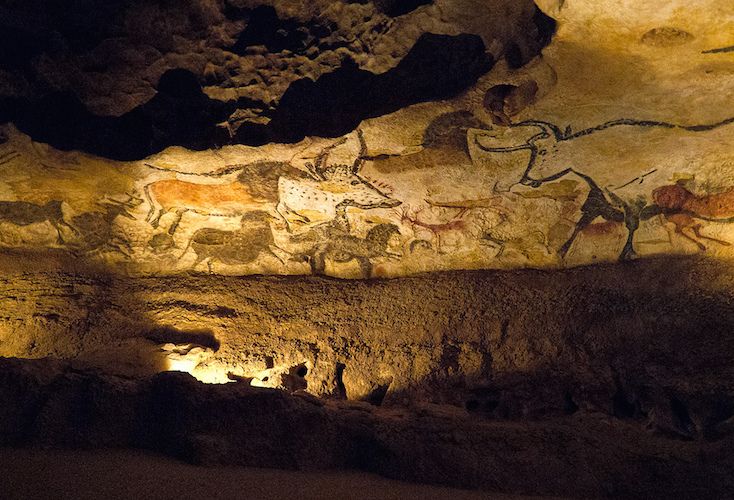
Image Courtesy of Smarthistory.
Form:
- Natural pigment (charcoal, ochre, soot, crushed up berries/flowers, etc.) on rock
Function:
- The purpose of this work is to represent the importance of animals to prehistoric hunter-gatherers as a source of food. This work could have been used to show members of the community about the animals surrounding them.
- Another theory is that the painting was used in religious rituals or during storytelling.
Content:
- Women are depicted gathering 👩🌾, while men are shown hunting 🏹, showing the stratification of labor by sex in the Paleolithic period.
- The various animals are drawn quite large, showing prehistoric people's respect for them.
Context:
- Because the cave is nearly 250 meters long and difficult to access, we can assume that it was meant to be entered by a specific group of people, most likely those who were well-respected. This supports the theory of the Great Hall of Bulls being a site for shaman's religious rituals.
- It is also said that people may have inhabited this cave for thousands of years. There are many overlapping, or superimposed images demonstrating the history of this cave. As new inhabitants (possibly nomadic peoples) used the cave for shelter, they continued the art by painting over already existing images.
Camelid Sacrum in the Shape of a Canine
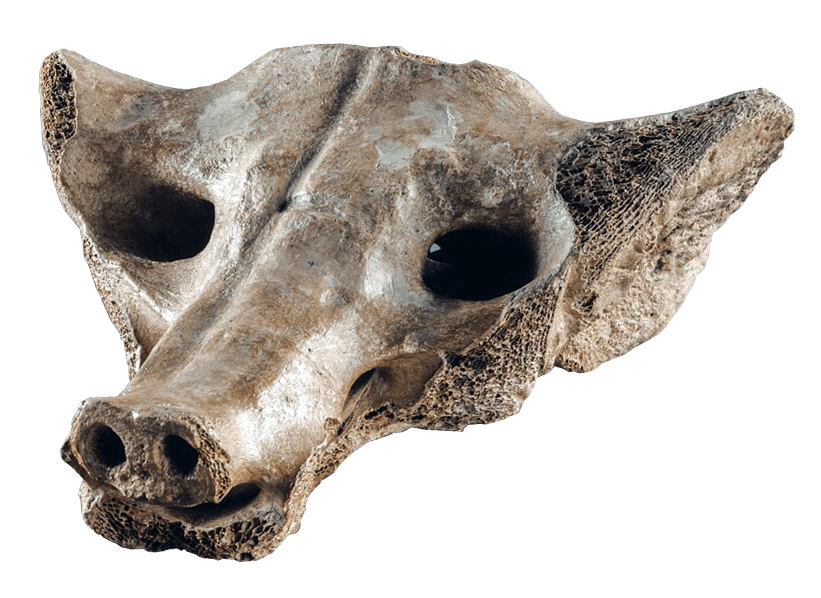
Image Courtesy of Obelisk Art History
Form:
- Bone, specifically from the sacrum (hip and tailbone) of an extinct camelid 🐪
Function:
- The function is unknown, but some art historians believe that it was made to represent what they saw in their everyday lives like a canine.
- It may have represented fertility, since the sacrum is located near the sexual organs.
Content:
- A camelid bone is carved using tools to mimic the face of a canine.
Context:
- The sacrum was seen as sacred by Mesoamerican cultures that came after this unit, such as the Aztecs and Mayans.
Running Horned Woman
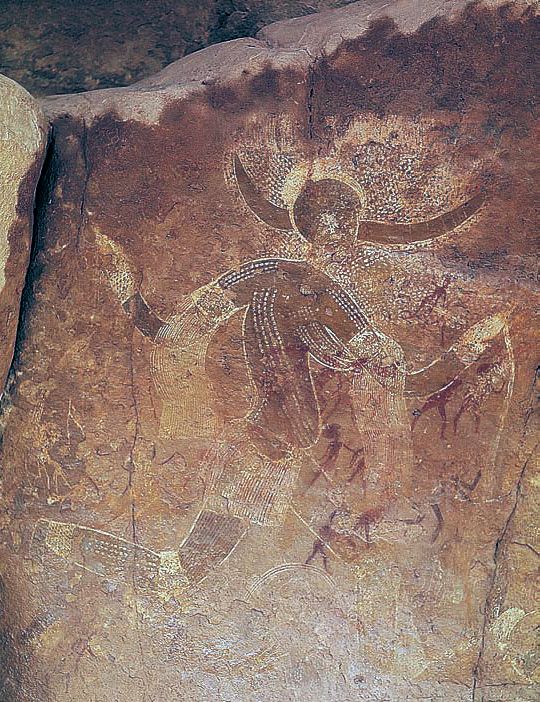
Image Courtesy of Khan Academy.
Form:
- Pigment (minerals mixed with a liquid) on rock
Function:
- Because it shows the main figure running and the humans in the background in movement 🏃, art historians believe that this work was made to symbolize survival.
- It may have also been made to represent the relationship between humans and animals, as evidenced by the animalistic horns on the woman.
- It could also have religious implications as a representation of God, or a "Mother Earth" figure.
Content:
- The pictograph (rock painting) pictures a woman in profile perspective running away from something unknown
- She is covered in white dots, which some believe to be body paint, while others think it is ritual scarification (which is a sign of beauty in some cultures).
Context:
- The work is in an elevated, secluded area ⛰️, which makes art historians believe that it may be located in what was a religious sanctuary.
- Hunter-gatherers did not dress like the woman depicted in the work. This means that her clothing and accessories may be symbolic of something.
Bushel with Ibex Motifs
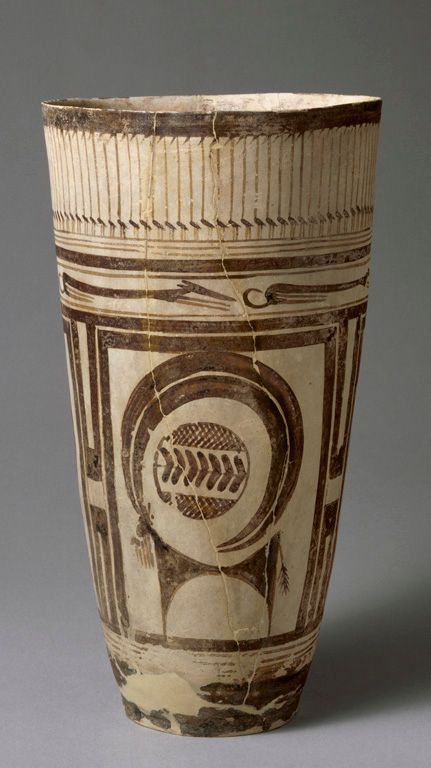
Image Courtesy of the Louvre Museum.
Form:
- Painted terra-cotta
Function:
- Bushel with Ibex Motifs was buried in the graves of deceased people, suggesting that it was a funerary item; meaning that it was in reverence of the dead.
Content:
- The work is a funerary bushel decorated with animal motifs, including a mountain goat 🐐, dogs 🐕, and birds 🐦, showing the prehistoric belief that a human's relationship with animals exists even in death.
- The curved horns of the ibex 🐏 contrast with the surrounding geometric (made with shapes) designs and linear necks of the birds near the mouth of the bushel.
Context:
- This work was found in Susa, Iran, which is near a fertile river valley. Because of this location, we can assume that Susa was a Neolithic settlement.
Anthropomorphic Stele
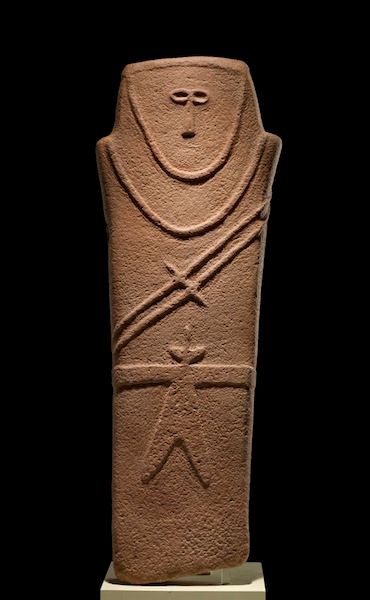
Image Courtesy of the National Museum, Riyadh.
Form:
- Sandstone
Function:
- Many works like the Anthropomorphic Stele have been found around the Arabian Peninsula, showing that they were valuable and important to prehistoric humans.
Content:
- The stele is of an anthropomorphic (something that has characteristics of a human, but is not actually one) figure.
Context:
- Steles are large upright rocks that contain information. This work was found along what used to be a trade route and is easily portable, suggesting that people would carry these while traveling. They may have possibly been used as good luck during travel, but art historians aren't completely sure.
Jade Cong
Image Courtesy of OHS APAH.
Form:
- Carved jade, which is extremely time-consuming and difficult to do.
Function:
- These congs were found in graves, which suggests that they are funerary items, purposely placed there to protect the deceased in the afterlife.
- Human and animal faces are carved into the cong, which may represent prehistoric humans' connection to nature.
Content:
- Decorated with lines and circles, that are believed to be faces of ancestors (possibly making this work some type of ancestor veneration) or religious deities.
Context:
- This work was found in the Yangzi River Delta of China, where Neolithic inhabitants had already began the transition to agriculture by planting rice.
Stonehenge
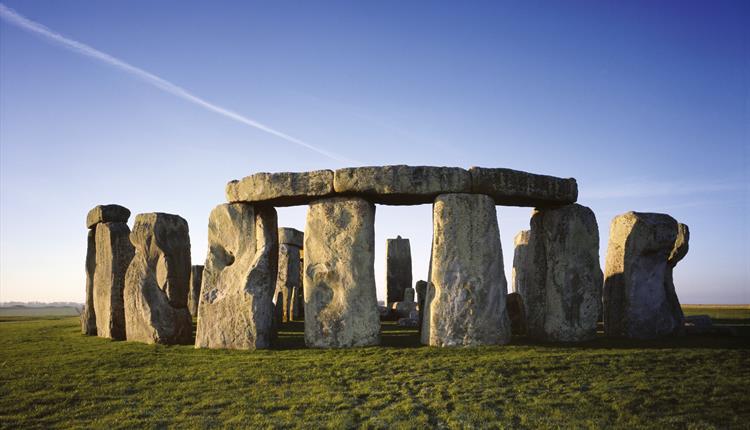
Image Courtesy of Visit Wiltshire.
Form:
- Standing sandstone pillars around 4 to 5 meters high
Function:
- Some art historians believe that Stonehenge was a burial site for well-respected, powerful members of society.
- However, most believe that it was an ancient astronomical observation center or temple for sun worshippers. It could have been used to mark when it was midsummer's solstice or midwinter's sunset based on the position of the sun. ☀️
Content:
- It is constructed of vertical rocks (posts), which are supporting horizontal ones (lintel) above. This method of construction is known as post-and-lintel, which we'll see even more of in Unit 2.
Context:
- Stonehenge was built over a period of 500 years, starting in 3100 BCE. Because so much time was dedicated to its construction, we can assume that it had an important purpose in Bronze Age England.
Ambum Stone

Image Courtesy of Khan Academy.
Form:
- Greywacke
Function:
- The function is unknown, but there are a few theories about how it was used. One of the more popular ones is that the Ambum Stone had a religious purpose, since the early people of Papua New Guinea saw anteaters as sacred animals.
- Some art historians believe that it was used as a pestle because of its smooth bottom.
Content:
- The work depicts either an anteater or an echidna.
- The content demonstrates a blending of human and animal features. Indicating the possible spiritual elements of the artifact: tying man and nature together.
Context:
- The prehistoric people of Papua New Guinea had settled communities going into the Neolithic period, which allowed them to spend more time on art.
Tlatilco Female Figurines
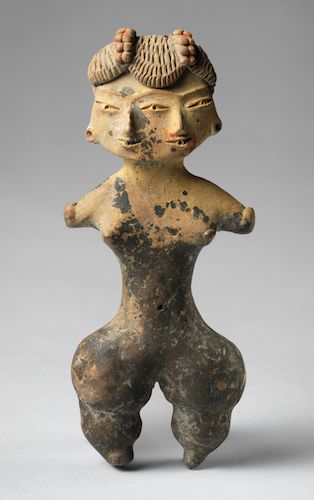
Image Courtesy of Khan Academy.
Form:
- Ceramic
Function:
- This work was most likely made to represent fertility and the importance of females in prehistoric society as mothers.
- It also may have been used in religious shamanistic rituals.
Content:
- Art historians have debated about why this female figurine has two faces. Some believe that the artist was depicting a woman with a congenital defect, but many also think that it was made to reflect the pre-Columbian artistic ideal of dualism.
- The woman has exaggerated thighs and hips with a narrow waist, and diminished hands and feet that places an emphasis on her body, possibly representing fertility.
Context:
- Tlatilco existed anywhere from 2,000 to 3,000 years before the Aztecs (you may want to remember this for Unit 5!)
Terra-Cotta Fragment
Image Courtesy of OHS APAH.
Form:
- Incised (a form of relief that involves scratching/carving imprints on an object) on terra-cotta
Function:
- The fragment once belonged to a much larger cooking pot that was either used for storing or cooking food
- It may have also played a role in ritualistic, religious ceremonies.
Content:
- The fragment is decorated with anthropomorphic images that were created using a technique known as dentate stamping. Artists would carve designs into natural materials like shells or wood and use them to stamp a design into the terra-cotta before it dried.
- The human face pictured on the work has linear features like the nose bridge, which contrast with the circular patterns on the rest of it.
Context:
- The prehistoric Lapita people of the Solomon Islands who created this work are well-known for their pottery.
Browse Study Guides By Unit
🗿Unit 1 – Global Prehistoric Art, 30,000-500 BCE
🏛Unit 2 – Ancient Mediterranean Art, 3500-300 BCE
⛪️Unit 3 – Early European and Colonial American Art, 200-1750 CE
⚔️Unit 4 – Later European and American Art, 1750-1980 CE
🌽Unit 5 – Indigenous American Art, 1000 BCE-1980 CE
⚱️Unit 6 – African Art, 1100-1980 CE
🕌Unit 7 – West and Central Asian Art, 500 BCE-1980 CE
🛕Unit 8 – South, East, and Southeast Asian Art, 300 BCE-1980 CE
🐚Unit 9: The Pacific, 700–1980 ce
🏢Unit 10 – Global Contemporary Art, 1980 CE to Present
📚Study Tools

Fiveable
Resources
© 2025 Fiveable Inc. All rights reserved.